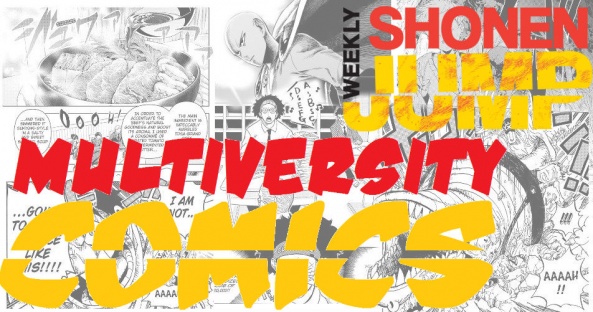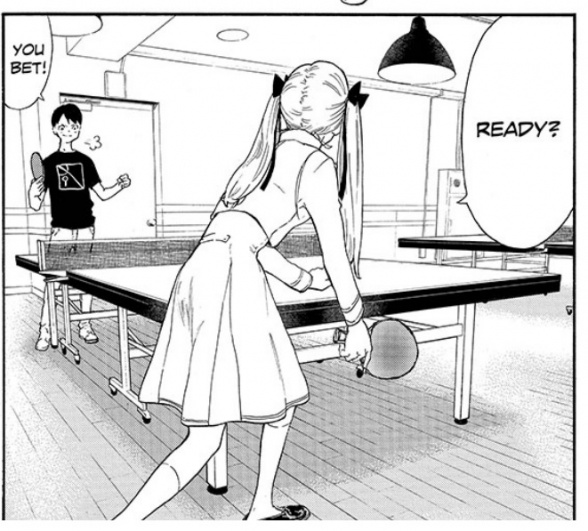
Welcome to This Week in Shonen Jump, in which a rotating duo of Multiversity staffers take a look at two stories contained in each installment of Viz Media’s Weekly Shonen Jump. For the uninitiated, Weekly Shonen Jump is an anthology that delivers more than 200 pages of manga of all varieties. We hope that you’ll join us in exploring the world of Weekly Shonen Jump each week. If you are unfamiliar, you can read sample chapters and subscribe at Viz.com.

This week, Vince and Zach check in with “Fulll Drive” and “Black Clover.” If you have any thoughts on these titles, or “My Hero Academia,” “Food Wars, “Dr. Stone”,” “We Never Learn,” “Lycopene The Tomatoy Poodle,” “Yu-Gi-Oh Arc V,” “One Piece,” or “The Promised Neverland,” or let us know in the comments!

Full Drive – Chapter 1
Written and Illustrated by Genki Ono
Review by Vince J Ostrowski
You’d be forgiven for thinking that “Full Drive” (Weekly Shonen Jump’s latest “Jump Start” entry) is just another sports manga with stock archetypes for main characters. After all, the main characters are a 13-year old boy who’s “short for his age” and not exactly confident and a 13-year old girl who’s practically a celebrity and extremely bossy, to boot. Stop me if you’ve heard this one before. But there are a handful of deliberately-placed hints that “Full Drive” could bypass a lot of the typical hangups that happen in these sorts of stories. On the other hand, this is pure inference; who knows, maybe in a few more chapters my faith in the series will be for naught. Either way, let’s dig in.
Dan Tamashiro is on his way to Japan via Germany after his table tennis master grandfather passes away after spending the last 5 years training Dan up. To honor his grandfather’s legacy, Dan is going to strive to become a true “fighter” (his words, not mine) of the sport. When he gets there, he immediately bumps into the current celebrity ping-pong star: Marin Shiraishi, who is about as over-the-top full of herself as it gets. She’s downright mean, and frankly one of the few downsides to this manga so far is her repeated jabs at Dan for being a “space case”, a specific insult which she probably says a dozen or more times in the first chapter alone.
But upon their meeting, writer/artist Genki Ono does some smart things that could speed up story a bit. Dan is portrayed as a pushover early on in the chapter, but at the table against Marin, he’s a confident and equal match for her right away. It did feel like the meek part of Dan’s character just completely fell away. Rather than seeing “the real Dan” at the table tennis match, his meek nature felt like something they’re not all that interested in to begin with. That’s fine, because it’s an overdone trope, but I wish they would have left that character trait out entirely. On a positive note, there’s some real joy on both of their parts from finding someone who is already challenging to play against, and that’s with no caveats. “Full Stop” looks to avoid one of these characters being immediately overmatched and having to prove themselves before moving on to bigger things. Marin, while incredibly arrogant, also let’s her guard down when it comes time to show Dan to their table tennis academy. She takes to him right away, avoiding the cat-and-mouse game these stories tend to sometimes play.
Genki Ono’s artistic approach is really impressive. The meeting of Dan and Marin and the dialogue heavy scenes concerning the non-sports events of the chapter are pretty much your standard manga fare. There’s not much to be said here other than the characters appear to be drawn appropriately to their stated age, which seems like an insane thing to bring up, but you read enough manga and, well, the less said about that the better. “Full Stop” isn’t problematic in that fashion. In fact, it even goes out of its way to put a giant exclamatory word balloon over a potential panty shot (which blankets it so it couldn’t even be called a “tease”) as if to explicitly say “this isn’t that kind of manga.”
Continued belowThe kind of manga it is is much more exciting: Genki Oni’s art makes the table tennis pretty thrilling. He uses a variety of angles, clear visual delineation between speed techniques and spin techniques, and extreme clarity to depict the match between Dan and Marin that sort of ends the chapter. What’s more, Ono paces the tennis matches well, punctuating them with earnest-feeling exclamations from the characters throughout. When Dan pauses mid-match to yell something halfway between a taunt and an expression of excitement, the reader feels the excitement come off the page. It’s all very well-timed from an artistic standpoint, so that the match feels varied the entire time.
If “Full Stop” continues to depict ping-pong matches with this sort of thrilling variety, and really is pushing past some character tropes that are frankly a bit overdone, it could be a stand-out sports manga in a medium that seems to be getting more and more of them all the time.
Final Verdict: 8.0 – “Full Drive” is a pleasant and well-paced sports manga with just a couple of minor kinks to work out as it gets its setting and characters established.

Black Clover Chapter #130
Written and illustrated by Yuki Tabata
Reviewed by Zach Wilkerson
Since its start, many (myself included) have made comparison between “Black Clover” and “Naruto.” “Black Clover” has certainly had an uphill climb in proving itself as a competent shone manga that stands apart from its familiar tropes. Of course, all manga has to start somewhere. Even the Multiversity Manga Club’s resident “Naruto Boy” didn’t begin to fall for that series until the Chunin Exams arc, nearly 100 chapters in. With that in mind, maybe there’s something special about tournament arcs that really allow shonen manga to shine.
Despite the large scope of the ongoing “Royal Knights” arc, it’s managed to remain remarkably focused. It’s brought certain interesting characters, like Finral and Mimosa, back to forefront, while also introducing and developing new characters like Xerx and the villainous Langris. This chapter continues this development, as the particularly Twisted™ character begins to shed his roguish persona for that of a hero. Xerx, or Zora, as we recently have learned his true name, softens somewhat in this chapter, both defending Asta and accepting assistance from Mimosa. Based on what we’ve learned from his background in previous chapters, Xerx could potentially be a strong addition to the cast, bringing a depth of character that the series has often lacked.
The plot of this chapter was rather brisk, focusing mostly on action and posturing. This plays into the chapter’s favor, however, as Tabata delivers some of the most outstandingly crafted pages in the series thus far. The image used for this review is perhaps the most striking in its composition. The scene itself is well framed, with Asta’s dynamic movement captured both with as straight-on front shot and a shot panning upward from behind.
Tabata’s facial work is equally commendable in this scene. Both expressions of the transformed and resilient Asta and the beleaguered Xerx capture a range of ideas and emotions. Elsewhere, Tabata’s ability to capture a character through facial expression is seen with Langris. The character’s features are occasionally wreathed in shadow, white eyes gleaming. At other times, the character is fully exposed, wild and manic. The creates an interesting light/dark dichotomy that speaks to both the character’s hate and the humanity that he shares with his half-brother.
Swinging back to the previously mentioned double page spread, this chapter closes out with a series of widescreen pages that effectively demonstrate the strengths of Tabata’s craft. The layouts of the last few pages play with perspective in interesting ways. Starting with page 184 of the Weekly Shonen Jump issue, we see Langris from Asta’s perspective. This shifts over the next two panels to a frontal view of Asta flying towards Langris, before finally shifting back to Asta’s view on collision. The following pages are full on wide screen, shifting to a horizontal view of Asta flying to the left with the flow of the page. Finally shifts once more, as Asta’s trail reverses back to the right, straight at the reader as he delivers two decisive blows. It’s a brilliantly composed sequence.
Between some enjoyable character work and particularly iconic imagery, this chapter of “Black Clover” stands out as among the best in recent memory. With a few more chapters like this, “Royal Knights” may become the best arc of the series. Even more, the series may be on the cusp of finally hooking this reader.
Final Verdict: 8.0 – Great art and design make this a stand out chapter for “Black Clover.”






